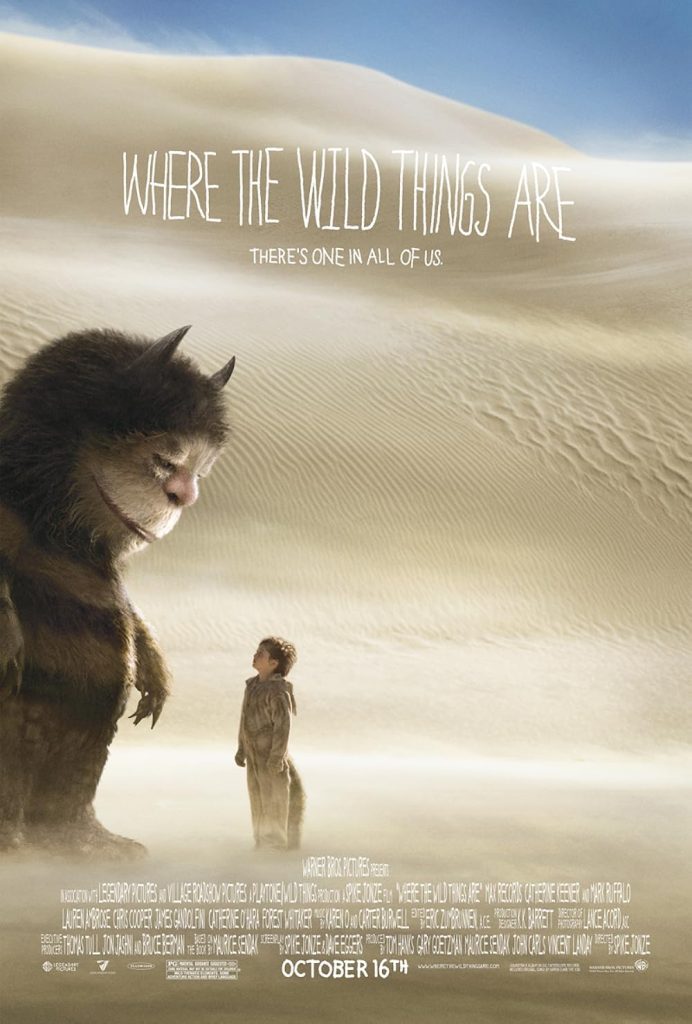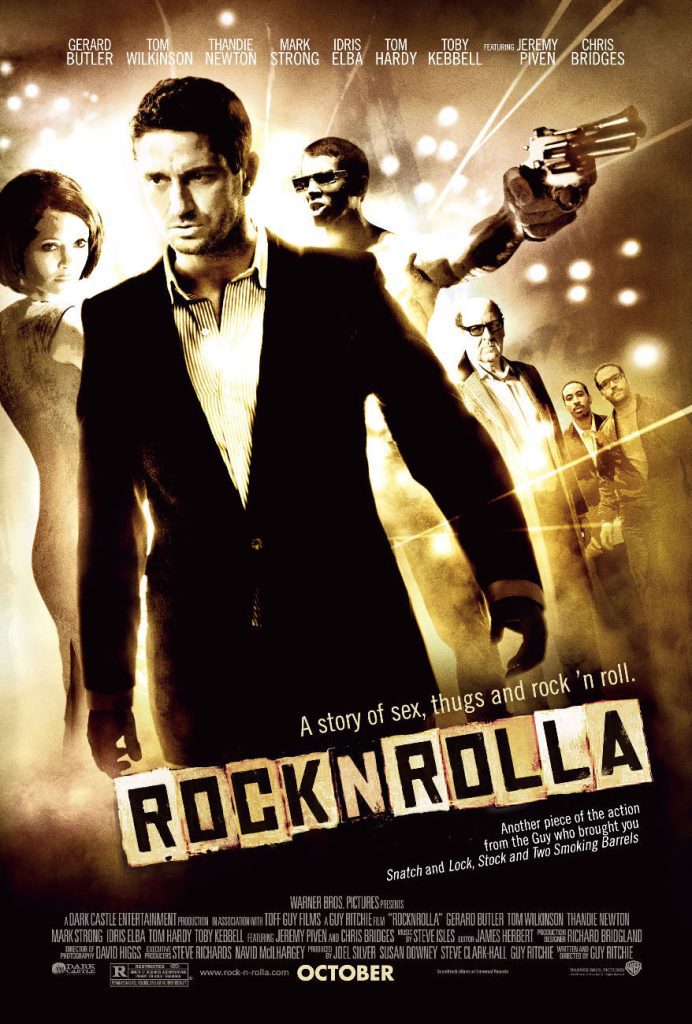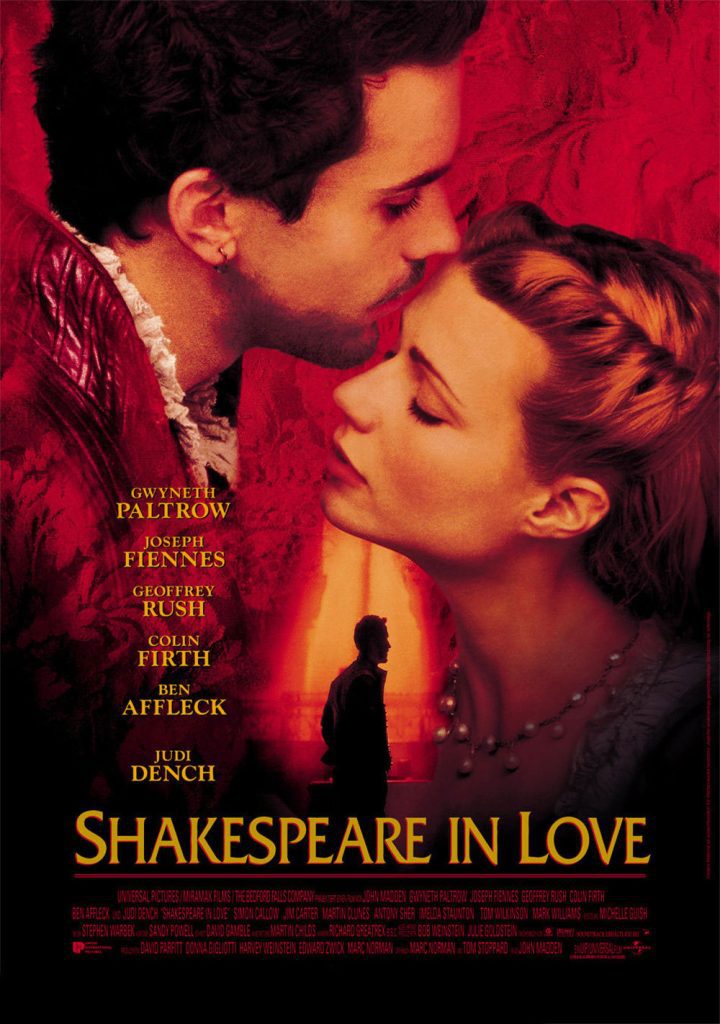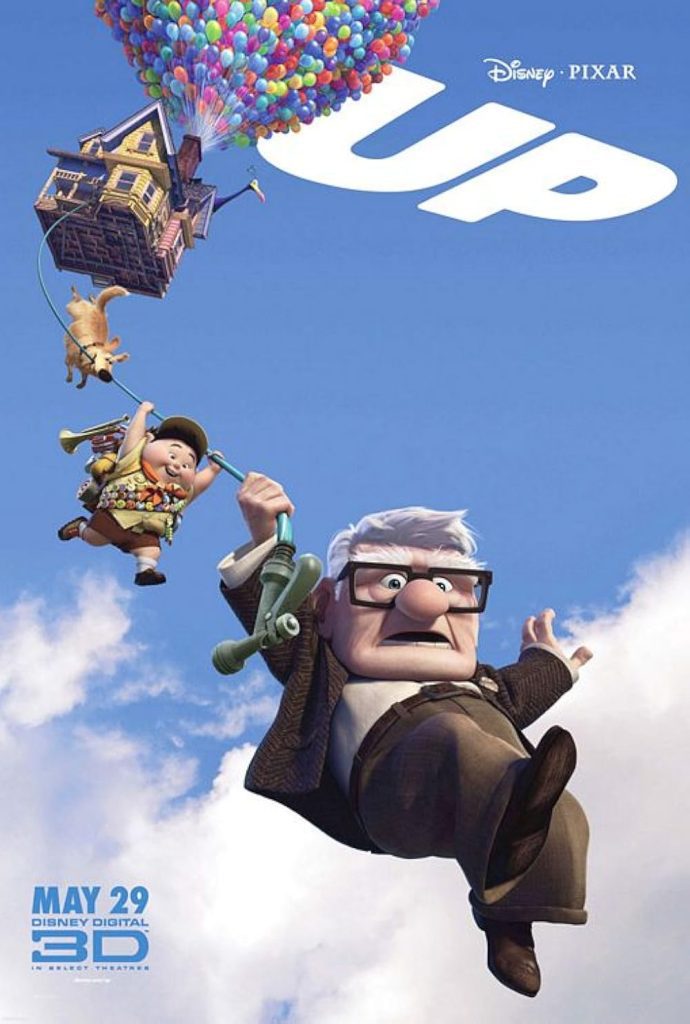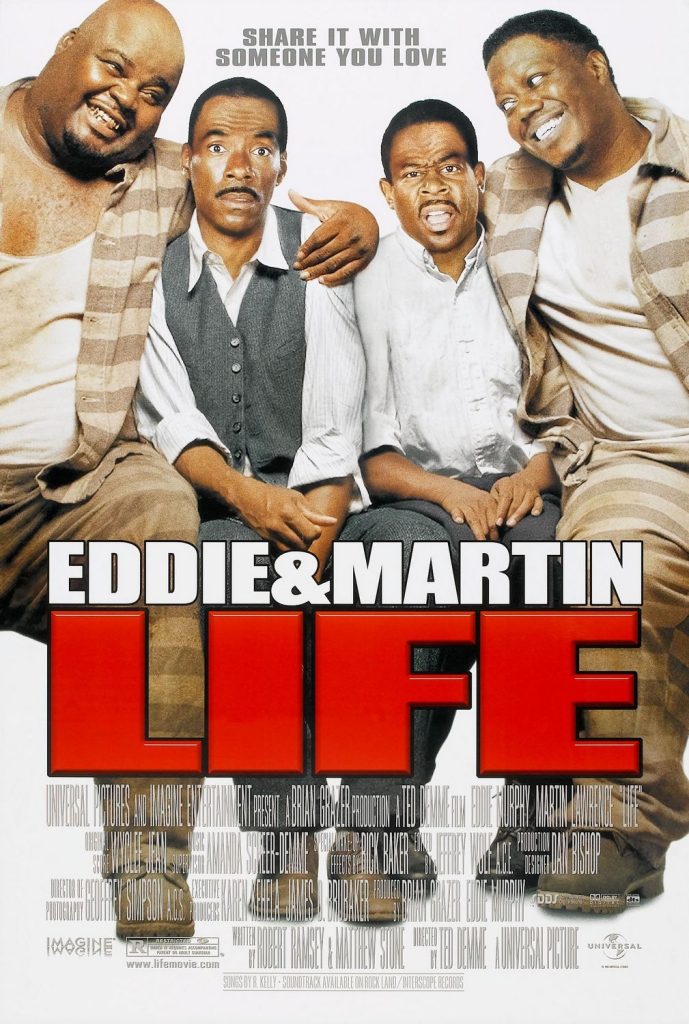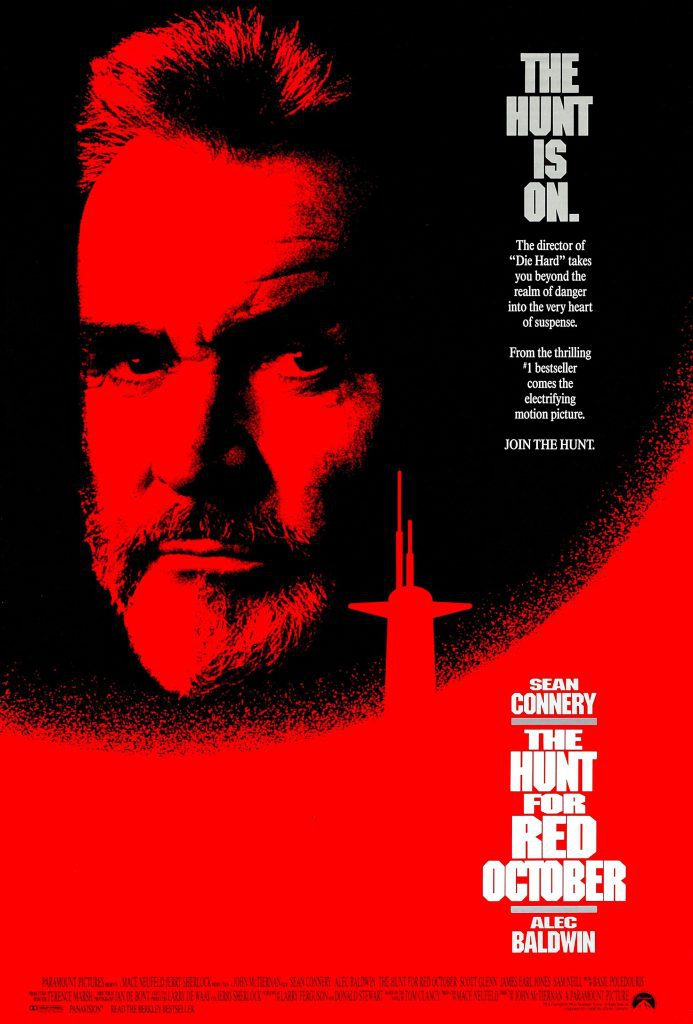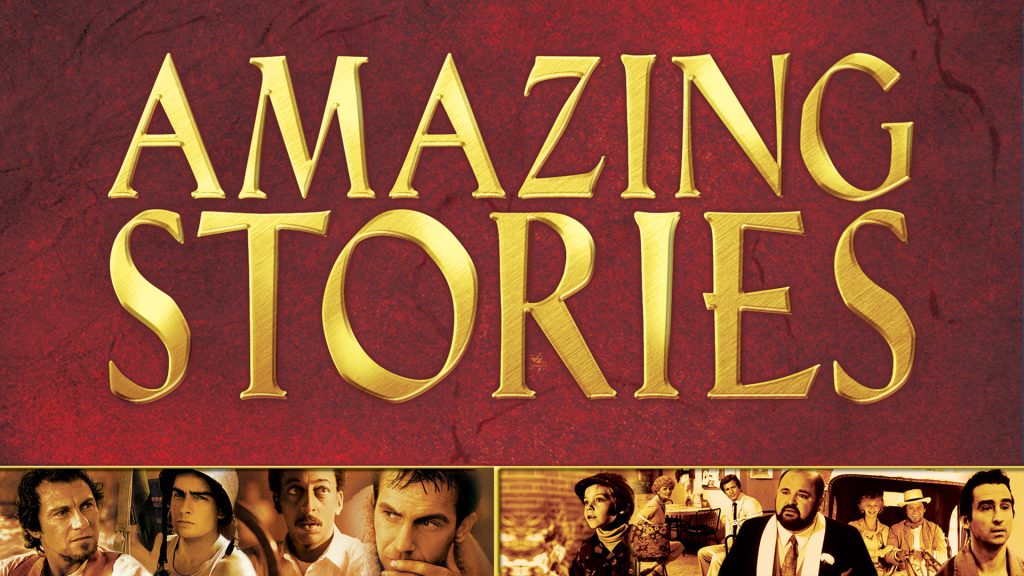
Although today’s film fans like to debate the merits of the world’s most successful filmmaker, during the mid-1980s Steven Spielberg could do no wrong. Still riding high off the unbelievable success of E.T.: The Extra-Terrestrial, Spielberg had his name attached as producer to almost every big family-friendly fantasy adventure to hit theaters. Always an idea man, Spielberg had so many script ideas in the air at one time, that instead of financing them all as features, he turned to television.
Amazing Stories, named after the classic sci-fi magazine, was something of a novelty on TV in 1985. It had been several years since an anthology series had aired, and critics often dismissed them as failures, seeing as how they don’t have regular characters for viewers to return to every week. But with Spielberg behind the wheel as executive producer, bolstered with movie-quality production values, how could it fail?
Backed up by insane amounts of hype, the debut of Amazing Stories was huge, but viewer numbers dropped thereafter, just as the critics predicted. This would have meant cancellation for most series, but Spielberg and his team had enough clout to contract a deal with the network that not only guaranteed production of two full seasons, but also a guarantee that every episode would air. (This meant that during the second season, hardly any viewers and no promotion gave the creators the freedom to be as completely nut-ball insane as they wanted to be. But we’ll deal with that once that season is released.) Now, years have passed and Amazing Stories has been given a new life on DVD. Want to find out what you were missing in the ’80s?
You find yourself transported back in time, sitting around a campfire with a group of primitive cavemen. One elder member of the tribe starts to tell a story, and the others listen carefully, caught up in the power of his words. You then feel yourself lifted up into the air, carried along with the sparks from the fire. Now you’re in an ancient temple, with a scroll unrolling in front of you. Moving upward still, you’re in a gigantic library, perhaps the one lost at Alexandria. Books fly overhead like birds, with their covers serving as wings, leaving behind an enchanted, glitter-like substance as they disappear into the sky. Next, you travel down a dark path with a human skull floating in mid-air on one side of you, and a painting of a haunted house on the other. Just as a glowing green ghost emerges from the painting, you turn your head away in fear. The ghost dissipates when a magician’s hat flies by, with cards and a wand spilling out from within. Then, you’re looking at another book, one with an illustration of a knight in shining armor. He suddenly springs to life, swinging his sword furiously at an unseen enemy. The two swords clash in explosion of bright white light, out of which sours a gleaming silver spaceship. You’re in outer space now, following this ship as it approaches the Earth. When you break through the Earth’s atmosphere, you think you’re hovering over the lights of a city at night, but it’s actually a piece of computer circuitry, magnified to hundreds of times its original size. Electricity bursts through the computer’s inner workings, and, with a flash, you’re back where you began, listening to that caveman conclude his story. Only now, he’s doing it on a television screen, and you’re watching him in a suburban living room with a family of mixed ages. The elder patriarch — you assume he’s a grandfather — turns to the rest of the family with a kindly look on his face that seems to say, “Well, wasn’t that something?” What is this journey you have just taken? It’s no more than the opening title sequence of Amazing Stories, and it sets the stage for what’s to follow.
Some strange lights appeared outside of my bedroom window last night. When I looked into them, I saw this episode list:
- “Ghost Train”
Directed by Steven Spielberg! A young boy, bored after his family moves from Chicago to a farm out in the middle of nowhere, is thrilled when his grandfather comes to visit. Gramps is more than familiar with this piece of land, and entertains his grandson with stories of a train that crashed on the property when he was a boy. But when the old man insists the train is about to make a return appearance, mom and dad call the doctor and prepare to send him off to the loony bin. The little boy still believes, though. Hey, did you just hear a train whistle off in the distance? And why is the ground shaking?
With this debut episode, Spielberg revisits the mood he created with Close Encounters of the Third Kind. It starts off with a fractured family dynamic, and concludes with a big, magical event, laying on thick the childlike sense of wonder that Spielberg does so well. Like most episodes of Amazing Stories, it’s easy to see how this one could have been stretched into a feature-length movie. Whether it would have been a good movie is wide open to debate, but getting it in this half-hour size makes for some nice economic storytelling. When the entire plot builds up to one major event at the end, it’s best to get to the big moment directly, and without a lot of unnecessary filler. But then, Spielberg will put that idea to the test in another episode later on.
Grade: A
- “The Main Attraction”
Brad Bender (John Scott Clough, Phantoms) is the coolest kid in high school. He’s won just about every all-state athletic award you can imagine, every girl wants him, and almost every guy has pledged some sort of strange servitude to him. On the night before a competition to see who will become prom king, one he’s almost a shoe-in for, Brad is struck by a meteor. This leaves him with a mysterious and very uncomfortable side effect. But if Brad wants to be king, he’s got to be in school the next day no matter what — and there’s an even bigger surprise waiting for him once class is over.
This is a real “love it or hate it” episode. I personally think it’s hilarious, but I can still see why others are annoyed by it. John Scott Clough’s “popular guy” shtick gets old fast, I’ll admit, but his skill at physical comedy during the second half of the episode is a sight to see. Some won’t like this, or the overall “nerds vs. cool kids” stereotypes all over the place, not to mention the ’80s teen fashions run horribly amok, but I say the over-the-top feel of the episode is what makes it so funny. And, hey, this one was written by future animator Brad Bird, who also appears on screen as a scientist. Bird would later win an Oscar for The Incredibles, so I think it’s safe to say he knows a thing or two about storytelling.
Grade: A-
- “Alamo Jobe”
It’s the battle of the Alamo, and it’s not going well. Jobe, (Kelly Reno) a young soldier fighting to stay alive, is given an order to deliver a letter to a general. It’s at this point that he starts to see modern-day tourists walking through the field of battle, unaware of the chaos around them. When Jobe steps outside the Alamo’s doors, suddenly he’s in the present (the present of 1985, that is). Although confused by his new surroundings, he’s determined to complete his mission and deliver his letter, even with a whole squad of Texas police out to catch him.
One frustrating element to this episode is that there’s really no explanation of how or why Jobe is able to travel through time. Instead, he just does. Although there are a few laughs, such as Jobe riding a bus and attempting to use a pay phone, this is a mostly a fast-paced action-heavy episode, which will likely remind viewers of the great police cars vs. bicycles chase from E.T. This script was written by Joshua Brand and John Falsey, who were supervising producers for the entire series, and who would later go on to create another notable fantasy TV show, Northern Exposure.
Grade: A-
- “Mummy Daddy”
Making a monster movie is tough work, especially if you’re the monster. Harold (Tom Harrison) is playing a mummy in an all-night shoot, wearing an elaborate costume that hinders both his movement and his speech. When he learns his pregnant wife has gone into labor, Harold races to the hospital, in full costume. One problem: the small town where the movie is being filmed is the site of an actual mummy legend (one that bears a striking similarity to 1944’s The Mummy’s Curse). Believing Harold is the real deal, a group of superstitious anti-mummy rednecks are out to destroy him at any cost. Will Harold make it to the hospital in one piece? And, hey, who’s that with the flashlight?
Here we have the creators making the most of a simple idea, and it works brilliantly. Easily one of the most fun episodes of the series, it starts out ludicrous and gets more and more ludicrous as it goes along, but it’s just so gleefully funny that you have no choice but to laugh, shake your head, and go along for the ride. Not only is it hilarious, but it’s helped by a raucous score by Danny Elfman, and a nice “monster movie” sense of atmosphere thanks to director William Dear (Harry and the Hendersons). A must-see.
Grade: A+
- “The Mission”
Directed by Steven Spielberg! It’s World War II. A motley crew of various soldier types boards a fighter plane for one last mission. There’s the heroic captain (Kevin Costner, Dances with Wolves), the brainy tech guy (Kiefer Sutherland, 24), and aspiring cartoonist Jonathan (Casey Siemaszko, Three O’Clock High), who is the crew’s “good luck charm.” But it’s hardly good luck when debris from a dogfight traps Jonathan in the belly of the plane while also preventing the landing gear from opening. This means the captain will have to land the plane on its belly, killing Jonathan as he does so. While the other members of the crew say their tearful goodbyes to their friend, Jonathan insists that he won’t die. It’s all a question of mind over matter.
Just as “Ghost Train” is all build-up to a big event at the end of episode, so is “The Mission,” except that “The Mission” is a special hour-long episode. This leaves Spielberg a lot of time to really develop the characters, and to wring every last bit of drama out of the situation. While it’s easy to look at “Ghost Train” and see how it could be stretched out to feature length, it’s similarly easy to look at “The Mission” and see how it could be pared down to a 30 minutes. The added length gives Spielberg some perhaps self-indulgent opportunities to pull at every heartstring possible. Although some will sneer at the various WWII clichés present, Spielberg and the actors make it all come together, so you get caught up in the story, even though you’ve seen this type of thing before.
Siemaszko once again nails an “everyman” role, coming across as a genuinely likable guy, one that you don’t want to see get squished by a plane. Costner always gets off on playing roguish heroes like the one here, and he does a fine job. Instead of Sutherland’s tough-guy Jack Bauer persona 24 viewers are familiar with, he adopts a geekier, bookish character in this episode. Sutherland has played this quirky type a few other times in his career, and he’s just as good at this as he is an action hero. Add to this mix some powerful visuals thanks to Spielberg and a handful of special effects that look to me like prototypes for the ones later seen in Who Framed Roger Rabbit? (another Spielberg production), and you’ve got an hour’s worth of entertainment well worth seeing, even if the script is rather lightweight.
Grade: A
- “The Amazing Falsworth”
A nightclub psychic, Falsworth (Gregory Hines, White Nights) has an act in which he surprises patrons by reading their minds while blindfolded. Only one night he reads the mind of a sinister serial killer, without ever getting a glimpse of the killer’s face. As he tries to get a detective to believe his story, Falsworth believes the killer is after him.
Amazing Stories takes an unexpected turn into almost-noir suspense territory with this episode. It’s directed by Peter Hyams, a dark guy who’s made dark movies like The Relic and End of Days. Even when Hyams directed a light and fluffy action movie with The Musketeer he still made it look all dark. “Falsworth” is similarly dark, both visually and in terms of subject matter. This intense and slightly bloody outing will be jarring for those viewers who’ve settled into a groove of family-friendly fantasy tales up to this point. Amazing Stories would go on to dip its toe in the horror genre a few other times, but this is the show at its darkest and most serious.
Grade: A-
- “Fine Tuning”
A teenage genius and his two buddies construct a homemade TV antenna capable of receiving signals from other states, other countries, and, after some tweaking, outer space. Broadcasts from old TV shows have reached the stars, see, and aliens on another world have become fascinated with them. So much, in fact, that they’re now on their way to Hollywood to meet their favorite celebrities in person. Armed with this knowledge, the three teens meet the otherworldly visitors and take them on a tour of Tinseltown.
And…the quality dips. First, there are dozen plot holes in this one. The timing of the aliens’ arrival and our heroes’ finding them all rely on coincidence. Furthermore, no one around Hollywood even reacts to these strange, obviously not-human beings wearing lame disguises trying to pass as human? And since when does a teen’s bedroom in a suburban house have a perfect view of the Hollywood sign? And what’s with the aliens’ fake-looking hands? Don’t even get me started on the whole “Polaroid” gag.
Beyond the dozens of nitpicks, this episode, like many Amazing Stories episodes, wants to combine the young and the old. It does this by creating a kid-friendly Spielbergian fantasy, and then adding a bunch of nostalgic throwbacks to the golden age of television and beyond. It works well enough in other episodes, but not in “Fine Tuning,” which seems to be aimed at the very young, with its broad, nonsensical humor, but also for older viewers, with its constant references to 1950s television, not to mention the parade of old-time vaudevillians doing their routines for the aliens. It’s the show’s first big misfire. Skip it.
Grade: D
- “Mr. Magic”
Magician Lou Bundles (TV icon Sid Caesar) has been a staple at a popular magic-themed nightclub for years. But now, age is starting to catch up with him, and he can’t wow audiences like the new crop of young magicians can. Once he finds an antique set of playing cards hidden away with some antiques at a magic shop, his luck soon changes.
Sid Caesar is really likeable in this one, so that you really care about his character and what he’s going through. By the time the “amazing” part of this Amazing Story shows up, it’s almost a distraction, because we’re so invested in Caesar’s character and what he’s going through. That being said, the special effects here are created with the best tech the ’80s had to offer (with a few strings here and there).
Grade: B
- “Guilt Trip”
Directed by Burt Reynolds! Dom DeLuise (The Cannonball Run) stars as Guilt; that is, the living embodiment of the emotion guilt. With just a few words and the occasional nifty special effect, he can make anyone feel guilt about their own bad decisions and self-destructive behavior. But Guilt has been feeling burned out lately, and has made a few mistakes while on the job. So, his boss (Charles Durning, The Big Lebowski) sends him on a mandatory vacation. Now aboard a cruise ship, Guilt meets and hits it off with a lovely woman (Loni Anderson, WKRP in Cincinnati), who is more than she appears.
This odd episode, in which emotions have magical human personas, is also one of the jokier ones, with DeLuise constantly making wisecracks every chance he gets. Fortunately, once his unconventional romance begins, he gets to show some heart as well. Anderson does a variation on the “hot, but nice” character she always plays, and she too gets a few moments to shine, even if the romance between the two is a little rushed, mostly thanks to the show’s 30-minute format. It’s too bad this episode never got a follow-up. It would have been interesting to see Durning bossing around some of the other living emotions out there.
Grade: B
- “Remote Control Man”
Walter Poindexter (Sydney Lassick) has a less-than-ideal life. He has a dead-end desk job, a nagging wife, a son in a cult, and another son who’s a wannabe punk rocker. His only solace is his nightly escape into prime time TV. When his wife sells the TV to pay for a (hideous) new outfit, Walter buys a high-tech new one. It’s so high-tech, that the remote can bring the characters on screen to life. It’s fun for Walter at first, such as when he replaces his wife with a beauty pageant contestant, but as he keeps clicking on that remote, the line between TV and reality keeps getting crossed. By the time its over, Walter’s living room will be trashed by a small army of TV characters and celebrity cameos.
Directed by Bob Clark (A Christmas Story), this is another comedic episode, offering viewers a free game of “spot the ’80s-era celebrity.” That being said, a lot of the humor in the early half of the episode comes across as a little too mean-spirited. Walter’s Mitty-ish life is a played very broadly, and with a little restraint the episode could have been funnier and a little less cruel. As it is, this one’s more a nutty piece of pop culture craziness than it is a well-thought-out story.
Grade: C
- “Santa ’85”
It’s Christmas! During his annual worldwide gift-giving spree, Santa Claus (Douglas Seale Aladdin) sets off a burglar alarm in the first house he visits. Suddenly, he finds himself under arrest, locked up in a cell with a bunch of Santa imitators and watched over by some humorless cops. But there’s still room for magic in today’s (that is, 1985’s) modern time.
This is another one that, with a little tweaking, could have been stretched into a feature film pretty easily. It’s a simple concept — Santa sets off a burglar alarm — and the creators run with it. Pat Hingle (Batman) plays the Sheriff who doesn’t believe in Christmas, offering a mean-but-not-frightening antagonist for good old Saint Nick. A lot of Amazing Stories episodes are aimed for kids, and this a better one of those. I mean, come one, it’s Santa!
Grade: A-
- “Vanessa in the Garden”
Directed by Clint Eastwood! Suddenly, we’re in gothic romance territory, where Byron (Harvey Keitel, Reservoir Dogs) is a painter about to make it big, with a display in New York. But when his beloved wife Vanessa dies in a freak accident, Byron gives in to despair and loses the will to paint. Then, in his darkest hour, he sees Vanessa again, in a scene recreated from one of his old paintings. Is her spirit reaching out to him from beyond the grave? Is there a way to reunite with her? Or has his depression led to madness?
Spielberg gets a rare “written by” credit for this one, and Eastwood gives it a similar look to his later film Midnight in the Garden of Good and Evil, even if that one has a totally different subject matter. Harvey Keitel throws himself into the role, as he always does, and his sadness at losing his wife is palpable. Some might feel that the solution to his misery is too simplistic, but with the story coming straight from Spielberg’s pen, perhaps that’s to be expected. Overall, though, this is a dark and serious episode, book-ended by some romance. There’s certainly nothing else quite like it among the rest of the Amazing Stories.
Grade: B+
- “The Sitter”
A recently-divorced mom seeks a sitter for her two incredibly rambunctious sons (one of whom is played by a young Seth Green, Robot Chicken). After a few disastrous babysitter encounters, the boys end up with Jennifer Mowbray (Mabel King, The Wiz), a voodoo priestess who matches the boys’ pranks with a few tricks of her own.
What could have been a wild ride ends up too watered down for its own good. I went into this one expecting an outrageous, supernatural take on Home Alone. Instead, despite a few otherworldly high jinks, this one is mostly a sugary-sweet “message” episode about understanding the differences of others and kids learning to use the power of their own imaginations. It’s not a bad episode, exactly; it just doesn’t have that extra Spielbergian touch to make it a standout.
Grade: C
- “No Day at the Beach”
It’s WWII again, and we meet a group of young, inexperienced soldiers the night before their first battle. While they’re mostly all buddies, sitting around to enjoy a game of cards, there’s no place in the group for the whiny, immature Arnold Skamp (Larry Spinak). He longs to fit in, even when the other guys constantly pick on him. It all changes the next morning, though, when the group storms a beach on enemy territory, and there’s a chance for some true heroism.
Although this one was written by Mick Garris (Masters of Horror) and directed by prolific TV director Lesli Linka Glatter (Twin Peaks), Spielberg’s style is all over it. This is a similar mood he would later take to Saving Private Ryan, with its dark WWII heroics. This episode is also filmed in gritty black and white, recalling the look Spielberg would later use in Schindler’s List. The relationship between the guys is played fairly down-to-Earth, unlike the goofy comedy antics in other episodes, and the battle might not be as elaborate or intense as the opening of Saving Private Ryan, but it’s plenty thrilling in its own right, with gunshots and explosions everywhere. This episode also guest stars Charlie Sheen (The Chase). He’s barely in it, though, so try not to blink.
Grade: A
- “One for the Road”
It’s a bitter winter in New York during the Great Depression. A group of down-on-their-luck drinking buddies come up with a plan to make some quick cash. They’ll get a drunken old timer to sign an insurance contract, and then kill him off, making it look like alcohol poisoning. Only, it doesn’t go as planned. No matter what these guys do to kill off the old fop, he keeps showing up the next day at the pub, looking for his next drink. How do you get a dead guy to stay dead?
This exercise in dark comedy features James Cromwell (Babe) and Joe Pantoliano (The Matrix), as well as a bunch of other character actors putting on their best Irish-by-way-of-New-York accents. It’s amusing enough, and reminds history buffs about the legends regarding Rasputin and his alleged invulnerability. Like most episodes of Amazing Stories, this one doesn’t offer much in the way of explanation as to how the “magical” part of the story happens — that’s just the way it is. In most cases, that’s fine; you just go with the flow. But the ending of “One for the Road” is just ambiguous enough that it leaves viewers wondering just what powers were at work to make this happen. The deleted scene for this episode offers a hint that, yes, there is a bigger picture to it all. As it is, though, it leaves a lot of questions unanswered.
Grade: B
- “Gather ye Acorns”
Young Jonathan would rather read comic books and listen to adventure stories on the radio than study to be a doctor, as his father wishes. A mysterious woodland creature, identifying himself as “Mother Nature’s only son,” appears with a message that the world needs dreamers, and that Jonathan should never, ever throw away any of the precious childhood items in his room. As an adult, Jonathan (Mark Hamill, Star Wars) lives his life according to the creature’s advice, first in a desert shack filled with mementos from his youth, and then as a derelict wanderer, driving from city to city in his aging car, with only his collectibles to his name. Will the magical creature’s promises of a better future ever come true, or has Jonathan wasted his life, just as his father predicted?
This one is competently-made and all, with a performance full of quirks from Mark Hamill, and an overall sense of warm nostalgia, which fits nicely with the subject matter. What bothers me, though, is the “message” the episode attempts to deliver. Jonathan is promised riches beyond galore if he never gives up on his childhood, and yet he nonetheless spends the majority of his life in destitution. Mother Nature Jr. talks on and on about the importance of “being a dreamer,” but does hanging onto all your old toys and comics really count as “dreaming?” It’s not like Jonathan is an artist with a vision worth fighting for; instead, he sacrifices everything, his entire life, for his collection. I’m a toy and comic book collector myself, so you’d think this is the one episode that would really speak to me. Instead, there’s something about it that’s just “off.” Sure, there’s a happy ending (that’s not really a spoiler; this is a Spielberg production, after all) but when that happy ending comes at a cost of a lifetime of loneliness and misery, I have to wonder if it’s really that happy. And here’s a thought, why can’t Jonathan keep all his childhood mementos and go to college and get a good job at the same time? Why does it have to be an “either/or” situation? I would have enjoyed this episode much more if I had a better handle on what it’s trying to say.
Grade: Needs revision
- “Boo!”
Directed by Joe Dante! A couple of kindly old ghosts are upset when the harmless suburban family living in their house moves out, and in moves a sleazy porn director (Robert Picardo, Star Trek: Voyager) and his wife/starlet (Wendy Schaal, American Dad). These newcomers’ raucous ways conflict with the gentle ghosts’ old-time lifestyle. So our ghostly couple decides to do what ghosts do, haunt their house and scare the new residents into leaving. One problem: they’ve never done the “haunting” thing before, and they’ve got no idea how to be scary.
Yes, the plot here is remarkably similar to Beetlejuice, a movie that would come along a few years later. Only this ghostly couple doesn’t have a “ghost with the most” to do their scaring for them. This one continues the trend of bringing out old-time Hollywood legends to play roles, with veteran comedians Eddie Bracken and Evelyn Keyes playing the kind, elderly ghost couple. Watch Bracken’s various facial reactions throughout the episode for a few bonus laughs. Jim Carrey wishes his face was as elastic as Bracken’s. Overall, Dante plays this one strictly for laughs, but the various sex jokes seem a little out of place in what is mostly a family-friendly series. Still, it’s just quirky enough to make it better than some of the other comedy episodes this season.
Grade: B-
- “Dorothy and Ben”
Ben Dumfrey (Joe Seneca, Silverado) wakes up in a hospital, only to discover he’s spent the last 40 years in a coma. With no family and no home to go to, Ben wanders the halls of the hospital — now his only home — marveling at ordinary things like televisions and water fountains. But when he discovers a little girl in a coma, he believes he can hear her speaking to him, and that it’s up to him to save her.
Break out your Kleenex, because this one has nothing to do with special effects, and everything to do with tugging at your heartstrings. We spend the entire episode inside the hospital, with a little girl’s life on the line, and a kindly old man doing everything he can think of to bring her back from the brink. Spielberg is often criticized for being overly sentimental in his work, and although he didn’t direct this one (that would be Thomas Carter, director of Save the Last Dance), Spielberg’s trademark sentimentality is here in full force. Does it try too hard to elicit tears from viewers? That depends how close each individual viewer feels to these characters. Fortunately, Joe Seneca carries the episode nicely, and his performance alone saves the episode from descending into pure cheese.
Grade: B
- “Mirror, Mirror…”
Directed by Martin Scorsese! Jordan (Sam Waterston, Law & Order), an abrasive horror novelist, starts to see an image in his mirror of a phantom out to get him. Every time he sees his reflection, there’s the phantom, attempting to sneak up behind him and strangle him. With the help of an old girlfriend (Helen Shaver, The Color of Money) he has every mirror in his home covered up, and all ties to the outside world severed. But how long can a man escape his own reflection?
During the opening credits, film geeks will be beside themselves when Martin Scorsese’s directing credit appears immediately following images of zombies rising from the grave. That’s right, fans, Marty is directing supernatural horror. Although this one isn’t quite as dark as “The Amazing Falsworth,” it’s the season’s other entry in the horror genre. Scorsese makes the most of this one, wringing every bit of suspense he can out of the story. Waterson’s descent into madness and paranoia happens quickly, but that’s expected when every mirror shows someone trying to kill him. And, yes, that is Tim Robbins (The Shawshank Redemption) as the homicidal spirit in the mirror. This one has another ambiguous ending, but in this case it works, giving just enough information for viewers to debate among themselves about what’s really happening here.
Grade: A
- “Secret Cinema”
Jane (Penny Peyser) just wants a normal life, but her fiancée abruptly breaks up with her, her psychiatrist’s nurse gives her a bizarre makeover, her mother asks for her autograph, and she keeps getting hit in the face with pies everywhere she goes. Jane eventually finds her way to the Secret Cinema, where she discovers that her life isn’t what she thought it was.
What…the…hell?!? This is one strange, twisted 30 minutes. Not only does it open the door to the freaked-out weirdness that would later dominate the second season of Amazing Stories, it also foreshadows where the media would later go, hinting at future works such as Peter Weir’s The Truman Show and the current reality TV craze. Like The Truman Show, this one is better watched as a metaphor than as a sci-fi story. The overall dreamlike atmosphere of “Secret Cinema” is the best thing going for the episode, as it provides a disconnection from viewers’ reality. This allows viewers to steep themselves in the metaphor and not worry about connecting the dots of the head-scratching narrative.
Where did this episode come from? Turns out it’s a remake. Writer-director Paul Bartel (Eating Raoul) based this entire episode on his own 1968 short film of the same name. If any episode in this set could benefit from more bonus features, it’s this one. How did a, let’s face it, weirdo like Bartel get involved with Amazing Stories? How was it decided to remake his original Secret Cinema? Just what was going through Bartel’s head when he dreamed up this craziness? As it is now, all these questions go unanswered.
Grade: ???
- “Hell Toupee”
Directed by Irvin Kershner! Newbie lawyer Harry Ballantine (Tony Kienitz) is assigned to defend a lawyer-killing murderer, who was an ordinary guy before he got that new hairpiece. Before long, Harry figures out that it wasn’t the man who committed the murder, but the faux hair. Now, Harry has to track down and find this hair gone wrong before it takes over the mind of another bald man, and start killing again.
Of all the comedy episodes in this season, this is one of the funniest. Aside from the constant bald jokes, we get an evil hairpiece sneaking around the sets like some sort of fashionable rodent, not to mention the goofy antics of the world’s most hapless right-out-of-college lawyer. There’s no moralizing here, and there’s no magical sense of wonder. This one’s strictly about the laughs. Also, the effects team deserves much praise for bringing the titular toupee to life. I can only imagine how much work went into making something so lifeless appear so lifelike.
Grade: A
- “The Doll”
John Walters (John Lithgow, Third Rock from the Sun) is a shy, lonely bachelor in his 40s, who buys a handmade doll for his niece. She’s a little too old for dolls, though, so he takes it back, intending to return it to the dollmaker. He soon finds he can’t part with the doll. He speaks to it, baring his soul to it, as if it’s someone he knows. Discovering the key behind these feelings means John will have to come out of his shell and find the courage to knock on a stranger’s door.
Lithgow won an Emmy for his performance in this one, and it’s a popular favorite among Amazing Stories fans. So, therefore, it pains me to be one who goes against the grain, because I fail to see what all the excitement is about. The majority of the episode is just Lithgow talking to a girl’s doll. Many might see this as childlike whimsy, but instead it struck me as just a lot of whining. Add to that the predictable ending, and the whole affair strikes me as less than impressive. But, as I said, mine isn’t the opinion of most fans, so if you’ve enjoyed the series up to this point, you’ll likely enjoy this one a lot more than I did.
Grade: C+
- “One for the Books”
A meek, elderly janitor (Leo Penn) starts gaining knowledge from the classrooms where cleans the floors. After one night in a French class, he can speak the language fluently. Then, being inside a physics room turns him into a scientific and mathematic whiz. He keeps insisting nothing’s wrong, even as his unexplained genius expands. His wife (Joyce Van Patten) fears his newfound smarts will lead to trouble, though. When the scientific community puts him on a pedestal, it seems she might be right.
Although this is one of the less interesting episodes, it gets bonus points for offering a partial explanation as to how and why this week’s magical event happens, thanks to an out-of-nowhere surprise at the end. Beyond that, the script is fairly routine, with a janitor getting unnaturally smarter and smarter, and his wife gets more and more worried. Again, the ending saves it from being an utter bore, but it’s still not up there with the series’ best.
Grade: C-
- “Grandpa’s Ghost”
Edwin (Andrew McCarthy, Mannequin) spends a lot of time with his grandparents, helping out around the house and enjoying their company. When Grandpa (Ian Wolfe) dies, Edwin has a tough time helping his grandmother (Herta Ware) deal with her grief. Making it even harder is the fact that she is somehow able to still see and talk to her late husband.
Here’s another heartbreaker episode, carefully calculated to elicit tears from viewers at just the right moments. First we see the family react to the loss of a loved one right after it happens, and then we’re with them through the long, difficult process of letting go. Even after the titular ghost appears, this remains a weepy, melancholy episode. It seems a strange choice to close the season, although I find it interesting that the season premiere and the season finale both deal with grandsons and their grandfathers.
Grade: C+
Overall, Amazing Stories collected together a wide variety of talented folks, both up and comers as well as Hollywood old-timers, in front of the camera and behind, all giving it their best. Therefore, it’s a crushing disappointment that the only extras we get are a handful of deleted scenes. Most of these are brief, and wouldn’t have contributed much to their episodes, with the exception of the one from “One for the Road.” On the tech side of things, the video is soft, but with little defects. The 5.1 audio is solid, making the most of the music and the sound effects during the few action scenes.
Even though it wasn’t the highest-rated show on TV, which is what both the networks and the creators hoped for, it’s well worth watching. Sure, some episodes are standouts while others aren’t that exciting, but, when taken as a whole, Amazing Stories remains a solid piece of fantasy filmmaking, and a landmark of ’80s nostalgia. Now, bring on the insanity that is season two!
For more movies visit Soap2day.
